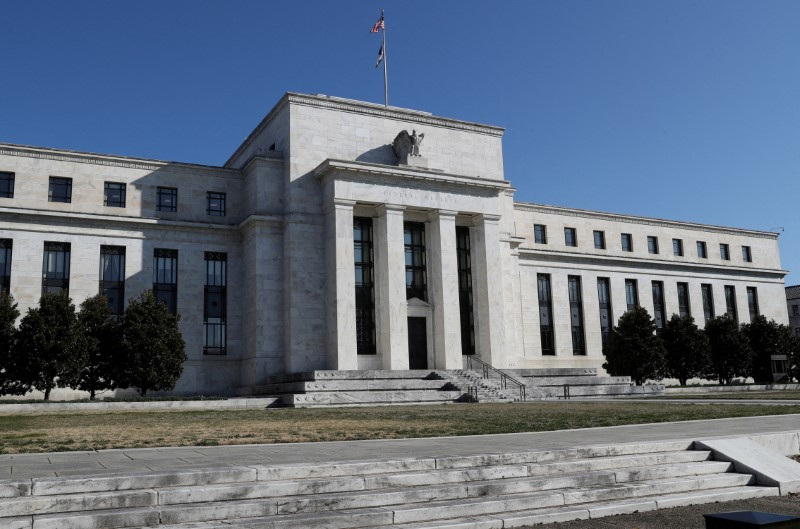By Jamie McGeever
ORLANDO, Florida (Reuters) -The Federal Reserve could comfortably lop a percentage point off its policy rate next year without changing its mantra of 'higher for longer' - what seems a contradiction is easily resolved.
Given the Fed's best estimate of a 'neutral' policy rate that neither stimulates nor slows growth or inflation is 2.5%, anything above that is essentially still bearing down on the economy. Policy remains 'restrictive,' in central bank parlance.
The Fed's official fed funds rate now is the mid-point of the 5.25-5.50% range, and rates futures market pricing has it being lowered to around 4.00% by the end of next year.
While markets are already nervy that expecting cuts of that magnitude may be jumping the gun given a persistent 'higher for longer' mantra and lack of recession, it would still leave the policy rate some 150 basis points above neutral.
At 4.0%, rates would still be far higher than they were before the tightening cycle began in March 2022 and around a full point higher than what markets assumed the end-2024 rate would be just a year ago.
A fed funds rate of 4% would still be higher than the peak of the last cycle, considerably higher than where it has been for most of the last 20 years and, in real terms, still the highest in several years.
And of course, as inflation ebbs further from here without any policy rate cut, the real fed funds rate is rising.
And if prevailing core PCE inflation rates of 3.5% were to fall to target, then the Fed could comfortably cut 150 bps without ever reducing the real policy rate - again, 'higher for longer' applies.
"That is probably the base case now in terms of likelihood," says Alex Etra, senior macro strategist at Exante Data and a former New York Fed analyst.
"'Higher for longer' is always a function of your base of comparison - it is possible the Fed could still cut interest rates and still have higher rates than previously experienced or higher than had previously been anticipated," he adds.
HIGHLY RESTRICTIVE
A trend has emerged over the last 30 years or so - the Fed is keeping its policy rate at the cycle peak for longer than it used to. If the first rate cut comes in May, as futures market pricing indicates, the 10-month gap since the last hike will be the second longest since at least the 1950s.
That could fairly be seen as keeping rates 'higher for longer,' in nominal and basic timeline terms. But the 'higher for longer' line that Fed officials drove for much this year is evaporating from market thinking.
Fed Governor Christopher Waller's hints on Nov. 28 that rates could be cut sooner than previously anticipated were significant. Fed Chair Jerome Powell had the perfect opportunity to push back against that view in prepared remarks and a question and answer session on Dec. 1, but chose not to.
Bond yields have slumped, implied interest rates have cratered, and the dollar has softened up.
Financial conditions have loosened considerably, at least as far as market-based indicators go. The Chicago Fed U.S. financial conditions index (FCI) is its lowest since February last year, and Goldman Sachs's FCI is the lowest in four months.
These indexes are compiled of financial market inputs like money market rates, equity prices, credit spreads, the dollar exchange rate, and long- and short-dated yields.
But if financial conditions for Wall Street have loosened over the past year, financial conditions for Main Street have tightened.
A range of 'Main Street' indicators like the Fed's Senior Loan Officer Opinion Survey show that the Fed's 525 bps of rate hikes since March last year are biting - bank lending standards are tightening, loan growth is turning negative, and delinquencies and bankruptcies are increasing.
Ultimately though, the most important financial conditions indicator is the Fed's policy rate, and whether it is accommodative, neutral, or restrictive for the economy at large.
The Federal Open Market Committee next week updates its Summary of Economic Projections, including the median estimate for the longer-run policy rate which has been 2.5% for almost five years, save for a brief dip to 2.4% in early 2022.
Assuming annual inflation returns to the Fed's 2% target, this implies a real neutral interest rate - the nebulous, holy grail of central bankers known as 'r-star' - of 0.5%.
New York Fed President John Williams said last week that some models suggest monetary policy right now is the most restrictive in a quarter century.
"I expect it will be appropriate to maintain a restrictive stance for quite some time ... to bring inflation back to our 2% longer-run goal on a sustained basis," he said last week.

Room to cut rates, and stay 'higher for longer.'
(The opinions expressed here are those of the author, a columnist for Reuters.)
(By Jamie McGeever; Editing by Andrea Ricci)